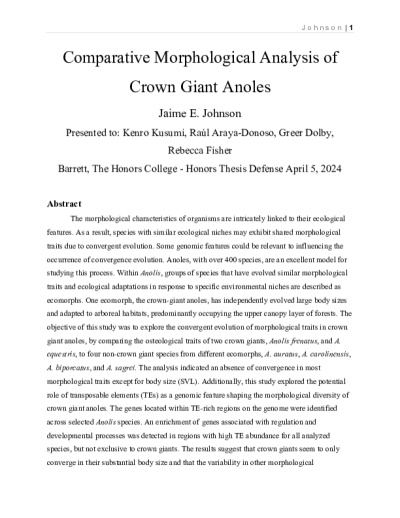Matching Items (11,856)
Filtering by
- Creators: Barrett, The Honors College
ContributorsDalvi, Tejas (Author) / Dudas, Caleb (Co-author) / Green, Aaron (Co-author) / Sanchez, Tomas (Co-author) / Casanova, Pablo (Co-author) / Byrne, Jared (Thesis director, Committee member) / Barrett, The Honors College (Contributor) / School of Public Affairs (Contributor) / Department of Finance (Contributor)
Created2024-05
ContributorsDalvi, Tejas (Author) / Dudas, Caleb (Co-author) / Green, Aaron (Co-author) / Sanchez, Tomas (Co-author) / Casanova, Pablo (Co-author) / Byrne, Jared (Thesis director, Committee member) / Barrett, The Honors College (Contributor) / School of Public Affairs (Contributor) / Department of Finance (Contributor)
Created2024-05

DescriptionI spent two semesters studying and making a Deckbuilding card game. I split my time between researching existing games and playtesting my own. In the end, I produced a fully developed game with printed cards.
ContributorsBarrantes Slivinsky, Andrew (Author) / Loebenberg, Abby (Thesis director) / Mack, Robert (Committee member) / Barrett, The Honors College (Contributor) / Department of Information Systems (Contributor)
Created2024-05
ContributorsDalvi, Tejas (Author) / Dudas, Caleb (Co-author) / Green, Aaron (Co-author) / Sanchez, Tomas (Co-author) / Casanova, Pablo (Co-author) / Byrne, Jared (Thesis director, Committee member) / Barrett, The Honors College (Contributor) / School of Public Affairs (Contributor) / Department of Finance (Contributor)
Created2024-05
ContributorsDalvi, Tejas (Author) / Dudas, Caleb (Co-author) / Green, Aaron (Co-author) / Sanchez, Tomas (Co-author) / Casanova, Pablo (Co-author) / Byrne, Jared (Thesis director, Committee member) / Barrett, The Honors College (Contributor) / School of Public Affairs (Contributor) / Department of Finance (Contributor)
Created2024-05
ContributorsDalvi, Tejas (Author) / Dudas, Caleb (Co-author) / Green, Aaron (Co-author) / Sanchez, Tomas (Co-author) / Casanova, Pablo (Co-author) / Byrne, Jared (Thesis director, Committee member) / Barrett, The Honors College (Contributor) / School of Public Affairs (Contributor) / Department of Finance (Contributor)
Created2024-05
Description
Wealth Wise is an innovative initiative targeting middle school students to bridge the gap in financial literacy within Arizona's challenging educational landscape. Through meticulous research, they aim to develop a comprehensive curriculum covering budgeting, investment, credit management, and banking principles, fostering critical thinking and financial independence. Collaborations with educators and interactive teaching methods are central to their approach, envisioning a future where financial literacy is fundamental to education, empowering a financially secure society.
ContributorsDalvi, Tejas (Author) / Dudas, Caleb (Co-author) / Green, Aaron (Co-author) / Sanchez, Tomas (Co-author) / Casanova, Pablo (Co-author) / Byrne, Jared (Thesis director) / Lawson, Brennan (Committee member) / Barrett, The Honors College (Contributor) / School of Public Affairs (Contributor) / Department of Finance (Contributor)
Created2024-05

Description
The morphological characteristics of organisms are intricately linked to their ecological features. As a result, species with similar ecological niches may exhibit shared morphological traits due to convergent evolution. Some genomic features could be relevant to influencing the occurrence of convergence evolution. Anoles, with over 400 species, are an excellent model for studying this process. Within Anolis, groups of species that have evolved similar morphological traits and ecological adaptations in response to specific environmental niches are described as ecomorphs. One ecomorph, the crown-giant anoles, has independently evolved large body sizes and adapted to arboreal habitats, predominantly occupying the upper canopy layer of forests. The objective of this study was to explore the convergent evolution of morphological traits in crown giant anoles, by comparing the osteological traits of two crown giants, Anolis frenatus, and A. equestris, to four non-crown giant species from different ecomorphs, A. auratus, A. carolinensis, A. biporcatus, and A. sagrei. The analysis indicated an absence of convergence in most morphological traits except for body size (SVL). Additionally, this study explored the potential role of transposable elements (TEs) as a genomic feature shaping the morphological diversity of crown giant anoles. The genes located within TE-rich regions on the genome were identified across selected Anolis species. An enrichment of genes associated with regulation and developmental processes was detected in regions with high TE abundance for all analyzed species, but not exclusive to crown giants. The results suggest that crown giants seem to only converge in their substantial body size and that the variability in other morphological characteristics could be attributed to some other ecological features or the phylogenetic relationships of each species. Moreover, TEs may play a role in facilitating morphological evolution and adaptability in all Anolis species, as they could influence gene expression and regulatory pathways. This highlights the need for further investigation into the genomic mechanisms determining convergent evolution.
ContributorsJohnson, Jaime (Author) / Kusumi, Kenro (Thesis director) / Araya-Donoso, Raúl (Committee member) / Dolby, Greer (Committee member) / Fisher, Rebecca (Committee member) / Barrett, The Honors College (Contributor) / School of Life Sciences (Contributor)
Created2024-05
Description
This paper analyzes the factors that contribute to suicide using current literature, statistics, and research towards what affects suicidal tendencies. It was found that there are 5 main factors that contribute towards these tendencies: economics, social factors, geography, politics, and biology. Additionally, some of these factors included subcategories of factors and/or were connected to the other factors mentioned. It was concluded that there is not just one factor that may contribute to someone taking their own life, however a combination of different factors that may influence suicidal tendencies.
ContributorsGeorge, Rhys (Author) / O'Flaherty, Katherine (Thesis director) / Hurtado, Ana (Committee member) / Barrett, The Honors College (Contributor) / School of Life Sciences (Contributor) / School of Human Evolution & Social Change (Contributor)
Created2024-05

Description
Recent satellite and remote sensing innovations have led to an eruption in the amount and variety of geospatial ice data available to the public, permitting in-depth study of high-definition ice imagery and digital elevation models (DEMs) for the goal of safe maritime navigation and climate monitoring. Few researchers have investigated texture in optical imagery as a predictive measure of Arctic sea ice thickness due to its cloud pollution, uniformity, and lack of distinct features that make it incompatible with standard feature descriptors. Thus, this paper implements three suitable ice texture metrics on 1640 Arctic sea ice image patches, namely (1) variance pooling, (2) gray-level co-occurrence matrices (GLCMs), and (3) textons, to assess the feasibly of a texture-based ice thickness regression model. Results indicate that of all texture metrics studied, only one GLCM statistic, namely homogeneity, bore any correlation (0.15) to ice freeboard.
ContributorsWarner, Hailey (Author) / Cochran, Douglas (Thesis director) / Jayasuria, Suren (Committee member) / Barrett, The Honors College (Contributor) / School of Mathematical and Statistical Sciences (Contributor) / Electrical Engineering Program (Contributor)
Created2024-05